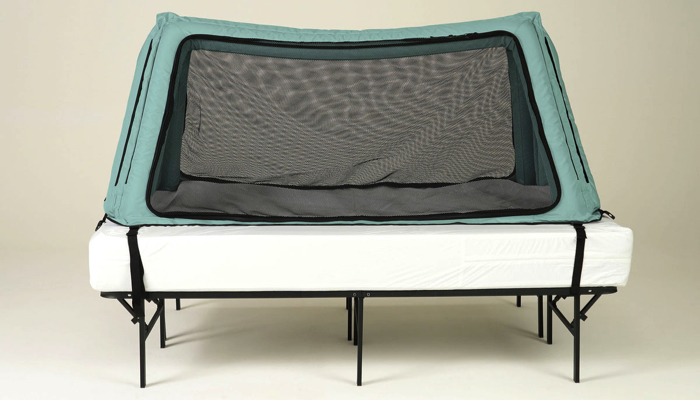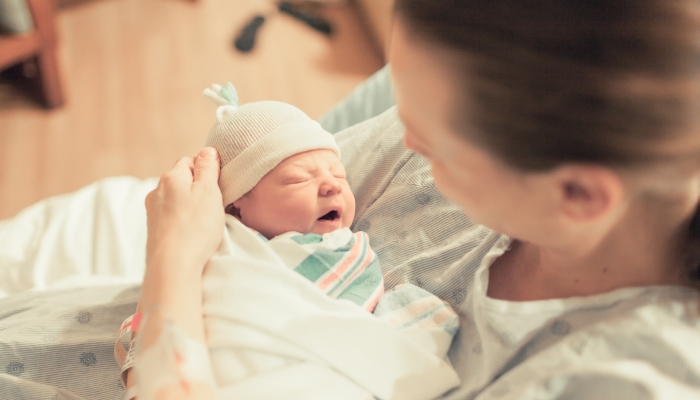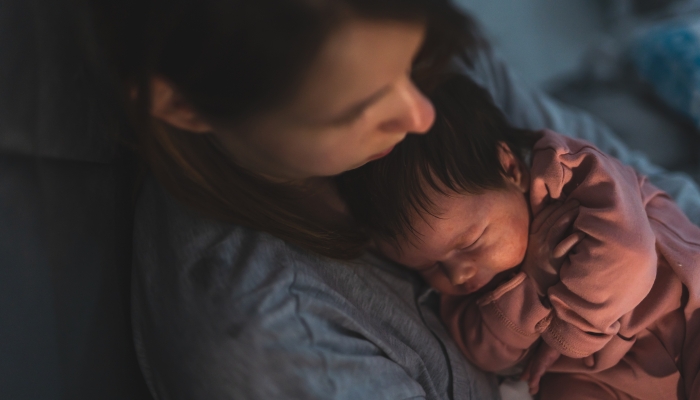The Eat Play Sleep Guide for New Parents

- An eat play sleep schedule helps teach your baby to fall asleep on their own.
- Each baby is different. Some will take to the eat play sleep schedule more easily than others.
- This method can adjust based on age and family schedule.
- Factors like scheduling, routine, and entertainment play a big role in making this sleep schedule a success.
- Eat play sleep can be implemented from the start or after you’ve settled into parenthood.
When soon-to-be parents think of all the awesome experiences their bundle of joy is yet to bring, I guarantee sleep deprivation isn’t one of them. The delirious state that mistakenly had my husband rocking a wadded up blanket instead of our newborn is definitely a stage I don’t miss. Not to mention the taste of my coffee, re-heated for what seemed like the hundredth time.
While I can say with confidence it was my least favorite part, I can also say it’s manageable if you lean into one thing: a routine. Maybe you’re here looking for a basic routine, or maybe you’re in the throes of sleep deprivation looking for a way out.
Whatever your reason, the eat play sleep routine just might be the solution to your midnight woes. A simple plan that packs a punch—you’ll be sleeping like a baby (pun intended) before you know it!
Eat Play Sleep: How Does It Work?
Okay, so now you’re wondering what this eat play sleep routine is all about, right? In short, it’s exactly how it sounds. Baby eats, has some sort of play time and only after that will they sleep. For some, this routine might feel like more work at first. After all, there’s no better relief than a baby falling asleep after a full feed.
Even so, you’ll soon find that the hard work upfront will be more than worthwhile. Why? The eat play sleep method helps train your baby to fall asleep on their own without rocking, eating, the need to be held, or other sleep associations that are easy to fall into.
Repeating this simple pattern throughout the day helps form the healthy sleep habits that make for a full night of rest for all involved.

Is the Eat Play Sleep Routine Right for Your Baby?
There’s no definitive answer on which routine is best; it all comes down to personal preference. While the eat play sleep routine is popular for good reason, that doesn’t mean it’s a one size fits all solution. Each baby is different and their personality, ease of feeding, and sleep patterns are all factors to take into consideration.
My first baby couldn’t follow eat play sleep if either of our lives depended on it. She became instantly “milk drunk” and as a new mom, I was all for it. Trying to keep her awake only stressed us both. To me, her natural need to sleep was a clear and overriding factor that this method wasn’t right for her.
Flash forward two years and my son was completely different. A full stomach prepped him for what I soon affectionately referred to as our “visiting hours”. He was the poster child for eat play sleep—like clockwork he followed the pattern. Two totally different experiences; each following the baby’s cues.
What works for some doesn’t work for all. Follow your gut!
What Age Can You Start Eat Play Sleep?
You can start this sleep training method at infancy, but as many moms can attest, getting a new baby to sleep is no small task. Neither is the entry into motherhood.
It’s because of this that it’s a good idea to give it a week or two to get your feet on the ground. Let the newborn sleep stage pass, establish a routine, and get baby used to feeding. At that point you can begin to work toward a consistent eat play sleep schedule.
The Eat Play Sleep Guide for Every Parent
Now you might be thinking all of this sounds great, but you have no idea how to actually implement this routine. No worries! Here’s a sample schedule to get you started. Based on a 3 to 6 month age range, it’s a great routine for beginners.
| 7:00 AM | Wake time |
| 7:15 AM | Eat |
| 7:45 – 8:45 AM | Play: Activity with caretaker |
| 8:45 – 9:30 AM | Play: Independent play |
| 9:30 – 9:45 AM | Sleep routine |
| 9:45 – 11:45 AM | Sleep time |
| 11:45 – 12:15 AM | Eat |
| 12:15 – 1:15 PM | Play: Activity with caretaker |
| 1:15 – 2:00 PM | Play: Independent play |
| 2:00 – 2:15 PM | Sleep routine |
| 2:15 – 4:15 PM | Sleep time |
| 4:15 – 4:45 PM | Eat |
| 4:45 – 5:45 PM | Play: Activity with caretaker |
| 5:45 – 6:30 PM | Play: Independent play |
| 6:30 – 6:45 PM | Sleep routine |
| 6:45 PM | Sleep time |
Keep in mind, none of this is written in stone. That’s the beauty of this method. You can adjust accordingly! As time progresses and naps grow fewer, eat play sleep will naturally phase out. Most children transition to one nap by age 2, making the move out of this routine a sure thing.

Tips to Make Eat Play Sleep Work for You
You’ve got the framework to make your eat play sleep routine a success, but there’s a few more tips and tricks to consider.
Exceptions
There’s a few scenarios where you’ll need to back off the routine. If your child is sick, chances are their normal patterns will fluctuate, especially their sleep. A recent study shows sleep to be imperative to a child’s development, even more so in sickness. That said, focus on getting them well, then pick up where you left off with the routine.
Sleep regressions are also cause for a more lax routine. Sleep regressions disrupt everyone’s sleep and a schedule can be harder to adhere to when your baby is overtired.
A growth spurt also puts the routine on pause as your babe needs more nutrients than normal. Closer feeds can make play time feel obsolete, so you may consider a looser schedule.
Scheduling
I know, I know, you probably see where this is going and you’re hesitant. You don’t want to be “those parents” that schedule their lives around nap time. I get it, but hear me out. Scheduling your day around naps saves you some major headaches. It’s also been proven to be best for your baby’s health and behavior!
You’ll be able to plan for outings with a well rested baby, not worrying when they might meltdown from an off schedule day. More scheduling now means a good night’s sleep for everyone in the long run. I don’t know about you, but I’ll take that trade off!
Routine
In the sample schedule above you’ll notice “sleep routine” comes just before the actual sleep time. It gets its own line, that’s how important it is!
A sleep routine is simply prepping your baby for sleep time. Much like a bedtime routine, it acts as a cue for them. They’ll start to recognize the same routine prior to sleep time, indicating to them it’s time to go to sleep. It doesn’t have to be anything elaborate, but it does need to be consistent.
For example, start with a diaper change and put their sleep sack on. Read them a book and afterward pat their back for a while. Then lay them down in their crib awake, ready to sleep.
Entertainment
Even with such a straightforward method, you might face some resistance leaving you to wonder how to get your baby into this routine. Simply put, it all comes down to entertainment. The play portion won’t go well unless you have diverse options to capture their attention. Otherwise, they may just try to sleep.
Think colorful toys from playmats to books and activity tables. Also, teaching toys with lights and sounds are great at keeping attention. Let’s be honest, when all else fails, any toy (or object for that matter) that’s new is sure to do the trick.
FAQs
I didn’t start eat play sleep when my baby was a newborn. Can I still use this method now?
Absolutely! It isn’t limited to a certain span of months. If you decide to start it later in the game, it’s not too late. Depending on your child’s level of activity and sleeping patterns, the eat play sleep routine can even last through the toddler stage.
Is the eat play sleep method supposed to be used throughout the night too?
Do not, I repeat, do not continue to eat play sleep throughout the night. I’ve talked to plenty of parents who have said they also play into the wee morning hours. They say their baby “stays up after a feed anyways”. Little do they know, it’ll come back to bite them.
The objective at night is to get them fed and back to sleep quickly. We’re trying to sleep train them using this method and their nighttime sleep is great practice. Skip the playtime at night!
How long should I let my baby sleep on this schedule?
The amount of sleep time in this routine hinges on your child’s age. Each stage requires a certain amount of rest for proper development. As a general guide, you can use the figures below:
- 0-3 months: Up to 4 hours per nap
- 4-13 months: Up to 2 hours per nap
- 14-24 months: Up to 3 hours total
Does eat play sleep work for breastfed babies?
It can definitely work for breastfed babies, but there are a few obstacles to consider. If your baby cluster feeds, the eat play sleep process can feel impossible. Also, a strict eat play sleep schedule may not allow you to drain your milk as often as you need to to stay comfortable.
Even so, both of these obstacles can be managed and don’t discount breastfed babies from the sleep training benefits of eat play sleep.
How do you eat play sleep if baby takes short naps?
Keep the overall goal in mind, which is your child’s ability to fall asleep on their own without the need for “props”. Many times, the culprit of these short naps are props like pacifiers and rocking. Your best bet is to distance your baby from these associations.
If you suspect feeding to be the cause of short naps try holding back half of their total feeding amount for mid play time. Try giving them the remainder of that feeding 30 to 45 minutes before they go down for their next sleep cycle. This gives them the feeling of being satiated without creating a sleep association.

Related Posts

Sleep, Special Needs
Safe Place Bedding Travel Bed Review
Traveling with a special needs child can be stressful! Having a safe, durable, and easy to use travel bed can make traveling so much easier!

Sleep, Special Needs
Sleep Regimen for Premature Babies: Special Considerations
It can take premature babies much longer than their full-term peers to sleep for long stretches. A preemie sleep schedule may encourage better sleep.

Sleep
Mastering the Bedtime Routine: 3 Tips for a Peaceful Night’s Sleep
From around six weeks, a newborn bedtime routine can help your baby learn the difference between day and night and prepare for a restful night’s sleep.